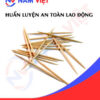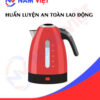Occupational Safety Training in Dental Floss Manufacturing
99,000 ₫
Note: The above price is calculated for one person, and the price may fluctuate depending on the number of trainees participating in the course and market movements. For more accurate pricing support, please refer to the quotation table or contact our consulting staff directly.
Occupational safety is an important issue in dental floss manufacturing factories and needs to be addressed promptly to ensure the health and safety of workers, while enhancing the reputation of businesses. The Occupational safety training course is one of the effective solutions to raise awareness of accident prevention for workers participating in dental floss manufacturing.
Table of Contents
Toggle1. Overview of Dental Floss
a. What is dental floss?
Dental floss is a tool used to clean teeth and maintain oral hygiene. It is used by inserting it between two teeth and pulling it through the gap to remove food particles and bacteria that a toothbrush cannot reach.
Dental floss is usually made from nylon or polytetrafluoroethylene (PTFE) fibers and comes in various types, including flavored versions to make the experience more enjoyable.

b. Types of machinery used in dental floss production
Machinery used in dental floss production includes:
- Nylon fiber production machines: These machines are used to produce nylon fibers of sufficient length and thickness for dental floss. The fibers are passed through a series of iron grids of different sizes to create different floss dimensions.
- Floss winding machines: These machines are used to package the floss after production. The floss is cut into small sections and wrapped in packaging of various sizes and shapes according to requirements.
- Printing machines: Used to print company names and logos on the packaging or directly on the floss to brand the product and enhance brand recognition.
- Quality inspection machines: These machines check the strength and flexibility of the dental floss, ensuring it does not break or snap during use.
- Packaging machines: Used to pack dental floss segments into standard packages, using various packaging technologies such as heat sealing, roll wrapping, and pneumatic sealing.

c. Dental floss manufacturers in Vietnam
Well-known global dental floss brands include:
- Johnson & Johnson: A multinational U.S. brand specializing in healthcare products and one of the leading dental floss producers.
- Oral-B: A famous U.S. brand producing oral care products, including dental floss.
- Colgate-Palmolive: A U.S. multinational corporation specializing in oral care, health care, and household products. Colgate also produces and markets dental floss.
- GUM: A globally popular dental floss brand with high-quality products designed for effective teeth cleaning.
- Reach: A Johnson & Johnson brand that produces and distributes oral care products, including dental floss.
- DenTek: A brand producing dental floss and oral care tools, with products specially designed to clean between teeth and under the gumline.
- Tom’s of Maine: A U.S. brand producing natural healthcare products, including dental floss.
These brands are trusted and widely chosen by consumers when purchasing dental floss products.
d. Specific roles in a dental floss manufacturing factory
Group 1
- CEO, Deputy CEO, Department Heads in the dental floss manufacturing factory.
Group 2
- Safety officers: Manage safety in the factory, design safety procedures, monitor, and enforce employee compliance with safety protocols.
Group 3
- Nylon fiber production: The main raw material for dental floss is nylon fiber. At the factory, nylon is processed to become dental floss.
- Floss winding: The fibers are fed into winding machines and wound into rolls for packaging and use.
- Product packaging: After production, dental floss is packaged into rolls and then boxed. The boxes are further packed into cartons for transportation.
- Quality control: Before packaging and shipping, products undergo quality inspections to ensure they meet safety and quality standards.
- Warehouse management: Finished products are stored properly in the warehouse to prevent damage or loss during storage and transport.
Group 4
- Office, service, sales, and marketing tasks.
- Production management, quality management, human resources, material management, and financial accounting.
- Research and development of new products and packaging design.

2. Overview of Occupational Safety Training for Dental Floss Production
In this article, we focus on Group 3 because Group 3 is directly involved in production and faces the highest occupational safety risks. For other groups, see here.
a. What is Group 3 occupational safety training?
- Group 3 occupational safety training consists of sessions that equip workers with awareness and methods to prevent workplace accidents.
- The training helps workers identify hazards and risks to minimize the likelihood of workplace accidents during work.
REGISTER FOR OCCUPATIONAL SAFETY TRAINING
b. Training duration
Initial occupational safety training
- The total training duration is at least 24 hours, including testing time.
- 8 hours of theoretical study on policies and occupational safety and hygiene laws
- 8 hours of theoretical study on basic occupational safety and hygiene knowledge
- 4 hours of theoretical study on specialized training content
- 2 hours of practical exercises on specialized training content
- 2 hours of final theoretical examination
The training center schedules sessions based on employee availability. Typically, there are 6 sessions over 3 days if continuous learning is possible.
Periodic occupational safety training
- Before the occupational safety card expires, workers wishing to renew must complete periodic occupational safety training, with the periodic training duration being at least 50% of the initial training duration.
Explanation: The total periodic occupational safety training lasts at least 12 hours, including testing. After completing the course and passing the test, the worker’s occupational safety card will be renewed.
c. Training content
| No. | TRAINING CONTENT | TRAINING DURATION (HOURS) | |||
| Total | Including | ||||
| Theory | Practice | Test | |||
| I | Occupational safety and hygiene laws and policies | 8 | 8 | 0 | 0 |
| 1 | Overview of regulations on occupational safety and hygiene. | 6 | 6 | ||
| 2 | System of standards and technical regulations for occupational safety and hygiene. | 1 | 1 | ||
| 3 | Specific regulations from state management agencies for building, expanding, or renovating facilities, as well as for production, usage, storage, inspection of machinery, equipment, and materials with strict occupational safety and hygiene requirements. | 1 | 1 | ||
| II | Basic knowledge of occupational safety and hygiene | 8 | 8 | 0 | 0 |
| 1 | Basic knowledge of hazardous and harmful factors at the workplace. | 4 | 4 | ||
| 2 | Methods for improving working conditions. | 1 | 1 | ||
| 3 | Safety culture in production and business. | 1 | 1 | ||
| 4 | Rights and responsibilities of employers and employees; policies and regimes regarding occupational safety and hygiene; functions and duties of safety networks and officers. | 1 | 1 | ||
| 5 | Safety and hygiene regulations, safety signs, use of protective equipment, first aid skills, and occupational disease prevention. | 1 | 1 | ||
| III | Specialized training content | 6 | 4 | 2 | 0 |
| Comprehensive knowledge of machinery, equipment, and substances that generate hazards; risk assessment and management; safe working procedures with machines, equipment, and substances with strict safety requirements. | 6 | 4 | 2 | ||
| IV | Final safety training assessment | 2 | 2 | 0 | 0 |
| Total | 24 | 22 | 2 | ||
See also training content of the 6 groups
d. Occupational safety card
After completing the occupational safety training and passing the exam, workers will be issued an occupational safety card (commonly called Group 3 safety certificate).
The Group 3 safety card displays information such as full name, date of birth, job, and specific working environment. It also includes training duration, a red seal, and signature confirming course completion.
According to Clause 2, Article 24 of Decree 44/2016/ND-CP, there are two cases:
- If there is an employment contract between the employer and employee, the employer must sign and stamp the safety card for the Group 3 worker after completing training and passing the exam.
- If the worker is freelance or seasonal with no employment contract, the training unit must sign and stamp the safety card after the worker completes the training and passes the exam.

3. Identifying hazards affecting workers in dental floss production
Some potential hazards in the dental floss production process may include:
- Risk of hand, finger, palm, or wrist injuries due to repetitive movements during production.
- Risk of chemical poisoning from exposure to chemicals such as cleaners or solvents.
- Risk of dust, fumes, or toxic gases exposure during production.
- Risk of eye or ear injuries from contact with tools, equipment, or materials used in production.
- Risk of cuts to hands, fingers, or palms from sharp edges or machinery during production.
- Risk of infection due to insufficient protective clothing or failure to follow hygiene and safety procedures.
- Risk of electric shock from electrical equipment in the factory that is not regularly maintained, lacks proper insulation, or is not waterproof.
4. Common Occupational Accidents for Workers in Dental Floss Production
Common occupational accidents in dental floss production may include:
- Hand or finger cuts and other injuries from using floss cutting knives or automatic cutting machines.
- Eye injuries or health hazards from using machinery such as floss weaving machines, coating machines, printing machines, or pressing machines.
- Chemical poisoning from using chemicals for cleaning, bleaching, or finishing dental floss.
- Self-puncture, inhalation, or ingestion of unsafe materials during production, such as metal fragments, dust, pollen, or other impurities.
- Accidents from using machinery like explosive devices, grinders, or air compressors.

5. Safety Measures When Participating in Dental Floss Production
Safety measures for participating in dental floss production include:
- Occupational safety training: Employees in dental floss factories need to be trained in occupational safety to understand hazards and accident prevention measures.
- Use protective equipment: Protective gear such as safety glasses, masks, gloves, protective clothing, safety shoes, etc., should be used properly and fully to minimize the risk of injury and contamination.
- Ensure cleanliness and food safety: Dental floss is a medical product and must be produced in a clean and food-safe environment to ensure product quality.
- Inspect and maintain equipment: Dental floss production equipment must be regularly inspected to ensure worker safety and product quality.
- Enhance workplace hygiene: Regular cleaning, maintaining clean work areas, properly storing dental floss, and correctly disposing of waste can reduce contamination and injury risks.
- Provide good working conditions: Ensure a comfortable, well-ventilated, quiet, dust-free, and non-toxic work environment to minimize negative health impacts on workers.
- Limit chemical use: If chemical use is unavoidable, workers must be trained in proper usage, wear full protective equipment, and follow correct waste handling procedures.
- Periodically conduct workplace environmental monitoring in the factory, collecting and analyzing harmful factors for workers, then adjusting to reduce hazards to prevent occupational diseases.
6. Benefits of Occupational Safety Training for Dental Floss Production
An Toan Nam Viet provides businesses with the following benefits after completing occupational safety training courses in accordance with Decree 44/2016/ND-CP on labor safety and hygiene for companies and enterprises:
- Workers can recognize potential occupational hazards and take preventive measures to avoid accidents.
- Businesses can establish risk prevention measures in production, operation, and maintenance processes.
- Minimize costs arising from safety incidents in the workplace.
- Continuous production helps increase labor productivity and product quality.
- Ensure compliance with labor safety laws and reduce legal risks.
- Enhance credibility and professionalism, boosting the brand image of the business.
Nam Viet’s training courses are a solution to prevent external hazards from affecting individuals, helping them avoid injuries or even fatalities.
REGISTER FOR OCCUPATIONAL SAFETY TRAINING SERVICE
7. Customer Feedback After Completing Occupational Safety Training for Dental Floss Production
An Toan Nam Viet has many years of experience in partnering with enterprises across Vietnam, especially in the southern provinces. This responsibility is highly valued by Nam Viet, which is why our Occupational Safety Training is increasingly professional. The motivation for our growth comes from positive feedback and constructive suggestions from our partners. Below are testimonials from clients we have served.
See more customer interviews after using our service from An Toan Nam Viet
8. Occupational Safety Training Capacity of An Toan Nam Viet
An Toan Nam Viet is a reputable and high-quality occupational safety training center in Vietnam, conducting continuous training sessions at production workshops, factories, or construction sites nationwide (63 provinces in Vietnam).
REGISTER FOR OCCUPATIONAL SAFETY TRAINING SERVICE
Occupational safety training license
- An Toan Nam Viet has been inspected and certified by the Department of Labor Safety under the Ministry of Labor – Invalids and Social Affairs, confirming our qualification to conduct occupational safety training, further strengthening our training capabilities.

Training materials and lectures
- Before the materials are used in occupational safety courses, they are reviewed to ensure accurate knowledge and effectiveness.
- Our teaching methods are standardized according to An Toan Nam Viet standards, developed by experts in occupational safety training to maximize knowledge absorption by trainees.
Facilities
- Controlling classroom factors affecting training improves teaching efficiency and knowledge absorption.
- Our training facilities provide spacious classrooms meeting standards for area, lighting, training equipment, etc.
9. Nationwide reputable occupational safety training center
At An Toan Nam Viet, we prioritize professional dedication to occupational safety training. Teaching workers how to protect themselves equips them for safe livelihoods and contributes to national development.
To ensure effective training, we meticulously prepare every detail, from teaching tools, equipment, curriculum, documents, audio, and lighting.
Our trainers are experts with many years of experience, including research projects identifying hazards in various industries and how to prevent them.
Lectures are practical, engaging, and easy to understand for workers, ensuring comfort and effective knowledge absorption. All training strictly adheres to Decree 44/2016/ND-CP.
Workers learn preventive measures and self-protection, applying them appropriately in real work situations.
Our training center is proud to offer professional occupational safety training services with advantages:
- Competitive training costs while ensuring quality.
- Flexible training schedules to match company operations.
- Quick certification procedures following legal regulations.
- Experienced trainers with many years in the field.
- Classrooms controlled to maximize teaching efficiency and knowledge absorption.
- Lectures tailored to corporate occupational safety requirements.
- An Toan Nam Viet works dedicatedly and professionally to provide fast and accurate support.

10. Additional reference materials for occupational safety training in dental floss production
- Occupational safety materials for dental floss production
- Complete set of occupational safety training materials
- Occupational safety training test sets
- Occupational safety training curriculum for dental floss production
- Occupational safety multiple-choice tests for dental floss production
1 review for Occupational Safety Training in Dental Floss Manufacturing
No comments yet















namchinh.haiphong341
Dịch vụ huấn luyện an toàn lao động rất tốt nhé, giảng viên dạy rất sinh động dễ hiểu!